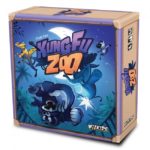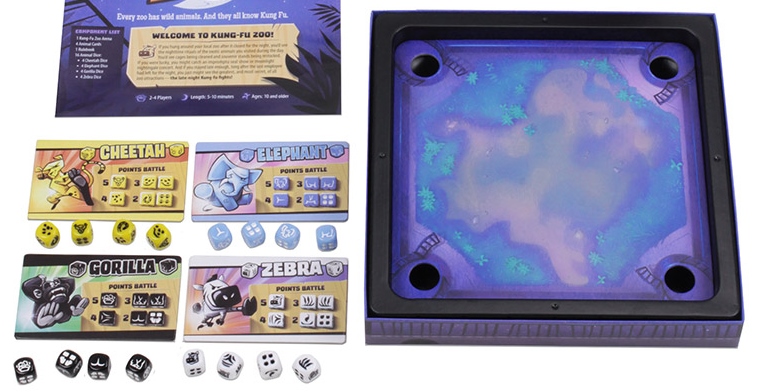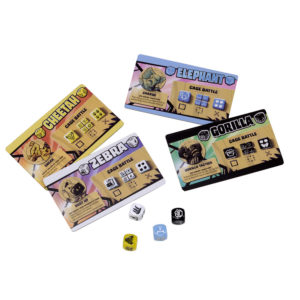Kung-Fu Zoo (Boardgame)
 Kung-Fu Zoo has players flicking animal-themed dice into an arena to score points and/or eliminate other players by knocking them into a corner pocket. A fast moving game of skill, with a healthy dose of luck, makes for a great game for younger kids even if it won’t have much staying power for older gamers.
Kung-Fu Zoo has players flicking animal-themed dice into an arena to score points and/or eliminate other players by knocking them into a corner pocket. A fast moving game of skill, with a healthy dose of luck, makes for a great game for younger kids even if it won’t have much staying power for older gamers.
Kung-Fu Zoo
Designer: Charlie Price
Publisher: WizKids
Players: 2+
Ages: 10+
Time: 5-10 minutes
(review copy provided by publisher)
Kung-Fu Zoo is comprised of four sets of animal dice and a box insert that turns the game box into a four-sided recessed arena, complete with corner pockets. The game revolves around flicking dice from outside the arena into the playing area in an attempt to flick one’s opponents into a pocket (the “cage”) to eliminate them from play. Eliminate all other players to win the game.

To add complexity to what is otherwise a simple dice flicking game, the side of a die facing upwards matters and each set of animal dice have a special ability. Each set of dice (Cheetah, Elephant, Gorilla, Zebra) displays six different sides of that animal (face, back, side, side, butt, and feet.) Dice that land with their feet up are considered out of play, as if they were already eliminated from the game, although they can come back if knocked onto an active side again. Players first take turns launching their dice onto the board from the mid-point of any side of the box. Once all dice are on the board, a player may pick up any die (except feet-up ones) and flick it at any of the other dice from the midpoint of any side. However, face-up dice have a special ability. Face-up dice can be removed from the board and then launched from any spot on the side of the box (they are not constrained to the midpoint.) If a player manages to “cage” another dice (and not one of their own) they get to go again.
The game provides two versions of play. A straight-up game of elimination, and a more nuanced battle for points, scored based on the sides of an animal showing. In a points game, a round ends once all four dice of a player have been launched (rather than when all all opponent dice are removed.) Point-based games with two players are scored on the differential (7 to 4 would score 3 points) while three or more players score points for all their dice.

A final addition to the game are special powers for each animal. Each animal has a special power that can be used once to affect game play. The cheetah player can, once per round, move one of their face-up dice to any location on the board. The zeebra, once per round, can force an opponent to make a shot with their eyes closed. The Gorilla can flick a die from on top of another feet-up gorilla. The Elephant can, once per game, can flick a face-up or back-up die directly from its location in the arena. Since they are one-use only, they do not have a huge effect on the game, but they add to the flavor of the game to make each animal (however slightly) different.
Verdict
Kung-Fu Zoo is a fun little dexterity game, one that includes some skill but also has a healthy dose of randomness. As with most dice, the sides are slightly rounded. Pair this with the ever so slightly bowed board inset, and dice will frequently end up spinning on their corner creeping ever so slowly towards one of the corner pockets. While somewhat frustrating from a skill perspective, it adds a wonderful sense of dread (or hope) as a spinning die gets nearer and nearer to the pocket before it comes to a rest. The special abilities of the animals are a mixed bag. It is fun to use them in a game, but I question whether they make much of a difference. While a zebra or cheetah ability will probably be used every round, I find it rare to use the gorilla ability to much effect. First, a die must land feet-up, and then it also needs to be in a useful location. The possible imbalance, however minor, makes little difference to the game’s target audience. My pre-teen sons, for example, could play this game all day given the chance. In this case, a bit of random chance is helpful as it makes a great equalizer. I’m not going to be bringing this one to a regular game night, but it will remain a welcome addition to our collection at home.
Kid Factor
The game lists an age range of 10+, but the game is entirely playable at a far younger age. The game should be approachable to any kid, as long as they are not likely to swallow one of the dice. There are cards for each set of animal dice that show the point value of each side of the die in a straightforward manner, with the only text on the card listing its special abilities. If playing by the point system, the numbers are low enough (single or low double digits) that the game could serve as a way to add in a bit of math at the preschool or kindergarten level.





Discussion Area - Leave a Comment